We are fortunate to work closely with five marine mammal species representing two families of marine carnivores (Otariidae and Phocidae) in our long-term program. Each of our resident animals is involved in an intensive training program that prepares them to cooperate in different behavioral and physiological studies, allows their health to be carefully monitored, and keeps them in good physical and mental condition. Our core animal teams are based at Long Marine Laboratory in Santa Cruz, CA and at the Alaska SeaLife Center in Seward, AK. At present, we are also working with ‘bonus’ ringed seals Spencer and Taku at the Alaska SeaLife Center, and one clever female Pacific walrus (Chou Chou) at SeaWorld.
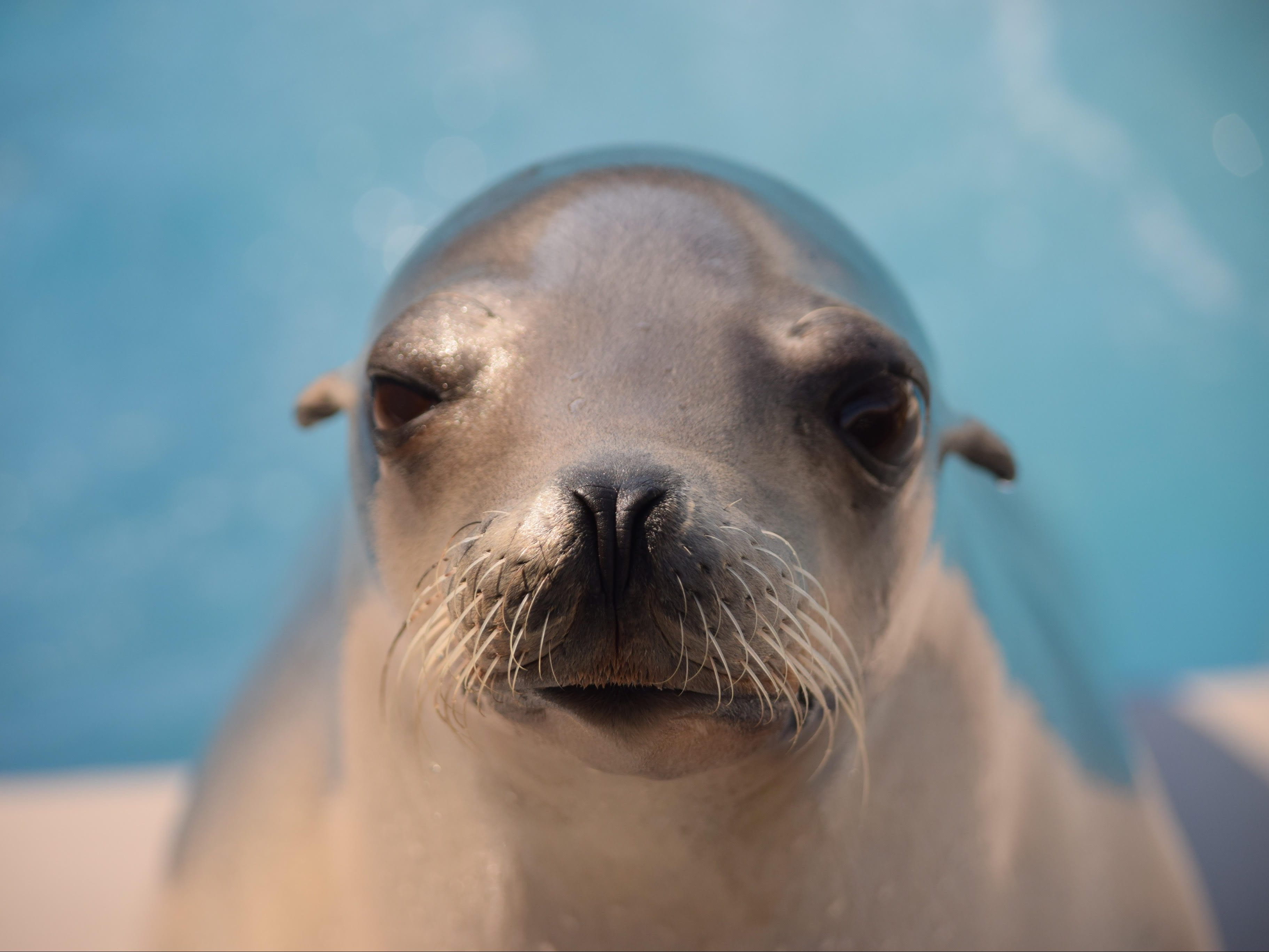
RONAN
California sea lion
Zalophus californianus
Ronan stranded in California in the summer of 2008, a particularly tough year for young sea lions. She had trouble finding food on her own and stranded multiple times as a pup. After being spotted walking down Highway 1 in 2009 she was eventually deemed unreleasable. Lucky for us, she joined our research team in 2010, and since then has helped us to learn about the sensory and cognitive abilities of her species. Ronan is especially well known for her work on biomusciality and rhythmic entertainment, and she maintains special relationships with her favorite people. Ronan keeps trainers on their toes as a quick and inquisitive learner with laser focus, keen to solve any new problem thrown her way.

RAINDROP
California sea lion
Zalophus californianus
Raindrop is the newest addition to our weird little crew. Raindrop was born at the Pacific Marine Mammal Center, CA on June 13, 2023. Her mother, Rainbow, stranded in San Clemente Beach during a harmful algal bloom and suffered from seizures and neurological abnormalities at the time of Raindrop’s birth. Rainbow’s condition was caused by exposure to domoic acid, an excitotoxin produced by Pseudonitzschia diatoms. Raindrop survived but could not be released to the wild. She joined our research program in January 2025 and she is now working with a team of veterinarians, investigators, and students to study the developmental effects of maternal excitotoxin exposure. Raindrop’s known in utero exposure to domoic acid will serve as a pilot case for a planned longer-term study of this environmental problem. This research builds on a long history of collaborative research and has implications for coastal and human health. Despite her difficult early life, Raindrop is a spitfire: curious, poised, clever, and mischeivious.

NOATAK
Bearded seal
Erignathus barbatus
Noatak joined our research team in the fall of 2015. He is a sweet, deliberate, and gentle animal who is currently helping us to collect the first documented data on both the hearing capabilities and physiology of ice-dependent bearded seals. Known as always being cautious of new situations, once he establishes his confidence he can accomplish anything thrown his way. He is named for the great river that runs into Kotzebue Sound in Northwest Alaska. He has a second name of Goodwin in honor of native hunter and seal biologist John Goodwin.

TUNU
Spotted seal
Phoca largha
Tunu was born April 4 2010 in the Yup’ik village Tununak. He somehow survived some harrowing first days of life without his mother and was rehabilitated at the Alaska SeaLife Center. Tunu has participated in sensory research and is an important member of the PHOCAS team. Tunu produces lots of underwater sounds in the spring and he loves to interact with visitors to ASLC through the windows. Tunu is an eager and smart training partner, and is known for his reliable and trustworthy nature.

KUNIK
Spotted seal
Phoca largha
Kunik was rescued as a small pup after washing up on a beach near Nome, Alaska in spring 2015. Kunik means “nose kiss” which is fitting as seals often touch nose-to-nose when greeting one another. Kunik is one zen seal. His relaxed attitude and inquisitive personality makes him a perfect participant on our PHOCAS project. Nothing better than morning meditation with Kunik.

SURA
Spotted seal
Phoca largha
Sura stranded as a newborn spotted seal near Clark’s Point, Alaska in spring 2014. Her name is the Inuit word for “green leaf” or new life. Sura has worked on the PHOCAS program since she joined the research team. Sura is a lovely, smart seal with a calm and steady presence and gentle nature. Sura is sweet but still full of surprises.
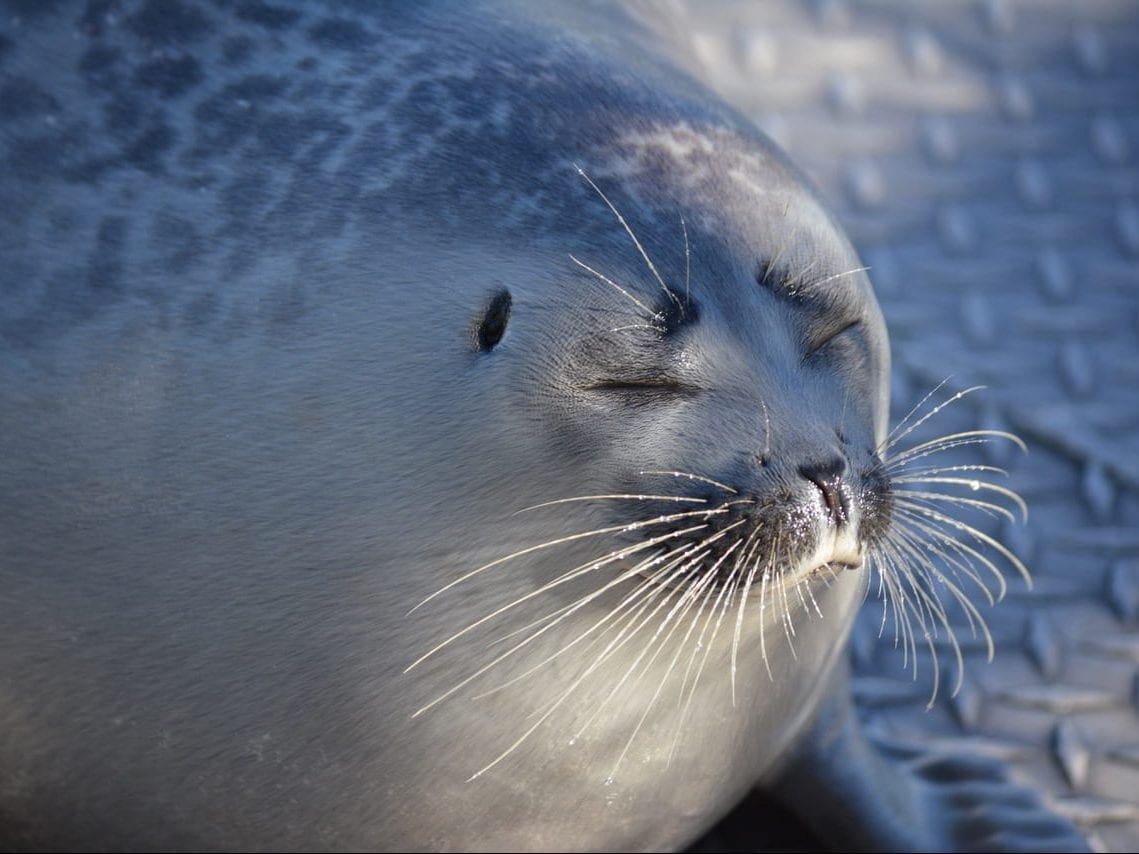
DUTCH
Ringed seal
Pusa hispida
Dutch is a small, very round female ringed seal with a big heart. She was stranded and then rescued near Dutch Harbor, Alaska in 2017 and subsequently joined our Alaska SeaLife Center research team. She is known for her bravery and lively spirit, as well as her stubborn streak. Some might consider Dutch to be a diva, but she has her own interpretation of that ringed seal independence.

PIMNIQ
Ringed seal
Pusa hispida
Pimniq is a male ringed seal who is part of our team at Alaska SeaLife Center. He stranded as a yearling in Stebbins, Alaska in summer 2015, and his name means “young or yearling seal.” Pim is nothing if not memorable. He is quirky, determined, fierce, and wary of new noises, and he has absolutely thrived in the cooperative training program. Pim is helping us to learn more about the unique biology of ringed seals, especially aspects of metabolism that change seasonally and throughout development.

TAKU
Ringed seal
Pusa hispida

SPENCER
Ringed seal
Pusa hispida
Ringed seal
Pusa hispida
Ringed seal
Pusa hispida
Animal Training for Research and Husbandry
Conducting cooperative research with marine mammals requires that trainers have a clear way of communicating with their animal partners. Much of animal training consists of linking up a trainer’s signals, an animal’s movements or responses, and carefully timed outcomes or rewards. Our training program accomplishes this through the use of classical and operant conditioning techniques that reinforce desired behaviors with fish rewards. The animals learn quickly to respond to the trainer’s tools, which include targets that the animals touch and track and conditioned reinforcers (like a trainer’s whistle) that mark particular responses. In this way, teaching various behaviors for research and husbandry can be broken down into simple steps and establishing new behaviors becomes a fun and rewarding process for the animal as well as the trainer. The training process can be used to shape specific behavioral responses and to encourage exploration and decision making.
The animals participate in the training process by making choices about how to respond in different situations. Their decision making relies on their current motivational state, memory of past experiences, and expectancies about the future. Because of this, the behaviors that an animal is trained to perform can illuminate internal processes like sensory events, learned associations, concept formation, and short- and long-term memory. Behavioral responses can also be used to establish the ideal conditions for making physiological measurements. An additional benefit of cooperative, interactive research is the stimulating and challenging environment created for our animals during the research process. In some ways, our research protocols simulate the wild environment because the animals encounter new situations and successfully solve novel problems on a daily basis.

Veterinary Care
Ensuring the health and wellness of the animals in our care is a joint effort between our team and our veterinarians, Dr. Megan Moriarty at Long Marine Laboratory and Dr. Carrie Goertz at Alaska SeaLife Center. We work together to plan and maintain a training program that meets the individual needs of each animal throughout physical and behavioral development. This involves establishing and practicing behaviors that allow us to monitor health and treat ailments, such as training the animals for physical examinations, blood draws, diagnostic ultrasounds and X-rays, collection of tissues and fluids, and even tooth brushing. We invest a great deal of deal of time in caring for our animals, consult regularly with other specialists, and keep detailed records on their health and behavior in order to provide them with the best possible long-term care.
Oversight of Animal Care
We are required by law to work with several regulatory agencies. The Office of Protected Resources, which is part of the National Marine Fisheries Service, provides our permit for maintaining and studying marine mammals (NMFS 23554). The USDA’s Animal and Plant Health Inspection Service regularly visits our lab to review animal care protocols, health and water quality records, and animal and food preparation facilities. Our government funding agencies have their own animal care and research protocol approval process which includes mandatory review of all research protocols and site inspections. Finally, the University of California Santa Cruz and all of our off-campus research partners have Institutional Animal Care and Use Committees (IACUCs), or Animal Welfare Committees, which conduct site visits and review and approve detailed protocols for each research project we initiate. UC Santa Cruz has also achieved AAALAC accreditation, a voluntary certification from the Association for Assessment and Accreditation of Laboratory Animal Care which demonstrates our continued commitment to ethical and humane treatment of animals. We work closely with all of these agencies to maintain the highest possible standards of animal care.
Past Animal Collaborators
Many individual animals have devoted their time and special talents in the service of science since the program’s inception. Each one holds a special place in the history of the laboratory. We recognize and honor their tireless efforts, their unique personalities, and their invaluable contributions to our understanding of marine mammal sensory biology, cognition, and behavior.

NAYAK
Ringed seal
Pusa hispida
Nayak came to our program as a yearling in May 2012 following her rescue in Nome, Alaska and rehabilitation at the Alaska SeaLife Center. She became an expert participant in various acoustic and physiological experiments at Long Marine Lab. Nayak was a beautiful seal with a spunky personality, described as being an independent perfectionist princess as well as a mischievous, sassy, and curious creature. Nayak’s name means “little sister” and she loves to tuck into ice castles and tubs. We are so grateful for the time we had to work with and learn from her.

SAKTULIQ
Bearded seal
Erignathus barbatus
Saktuliq, or Tuliq for short, was a female bearded seal who joined our program in 2019 after her rescue and successful rehabilitation at the Alaska SeaLife Center. Tuliq was the first bearded seal to be found stranded in Alaska who was able to be successfully rehabilitated. She was named Saktuliq in honor of the Alaskan village and river where she was found as a neonate by community members. This clever, inquisitive seal was a quick study who clearly loved science! Tuliq learned to participate in a range of experiments at Long Marine Lab, and she helped us to learn more about the biology and behavior of her species.
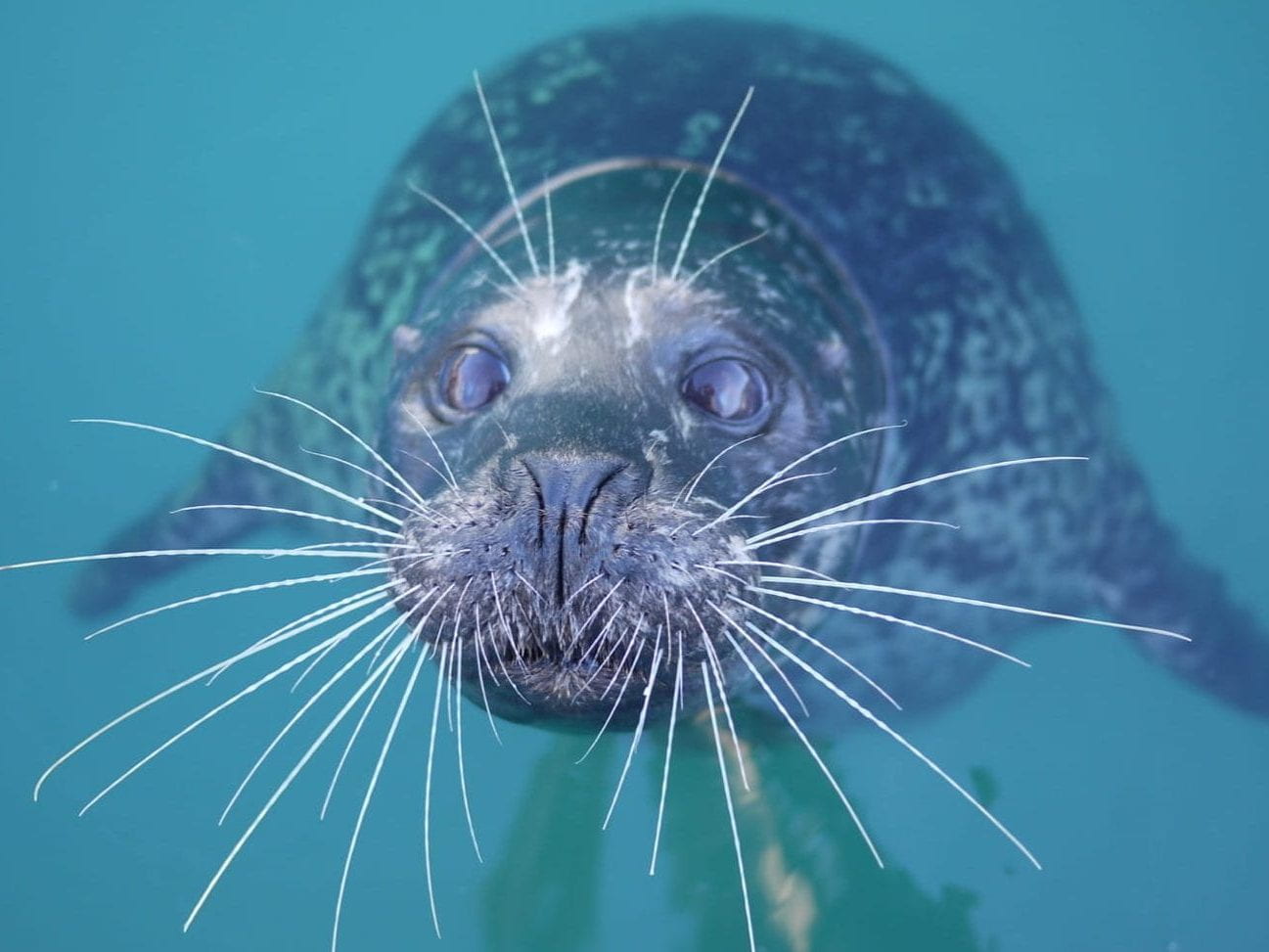
SPROUTS
It is with a heavy and grateful heart that we share the news that Sprouts, our harbor seal who was raised at UCSC’s Long Marine Lab since 1989, has died. Sprouts was a beloved seal that spent 31 years contributing to important scientific studies, supporting unforgettable educational opportunities for students of all ages, and training generations of future scientists, veterinarians, animal care specialists, and teachers. He embodied the spirit that we strive to create and sustain at the marine lab – as a place where marine mammals and scientists and students at every level work cooperatively together in harmony.
Sprouts was born on Earthday, April 22, 1988 at SeaWorld in San Diego, to a mum called Peas. He participated in research on diving physiology with Dr. Terrie Williams at Hubbs-SeaWorld Research Institute prior to making his way to Long Marine Lab where he joined the behavioral research laboratory of Dr. Ronald Schusterman at the age of 1. For the next three decades, Sprouts worked alongside our research team, and as his training and skills evolved, so did his ability to master complex experimental tasks. He eagerly participated in research projects on physiology, vision, audition, and hydrodynamic sensing, associative learning, and vocal learning and communication. He was often the first animal to be introduced to a new experimental design or apparatus, and he often patiently ‘debugged’ our equipment and training protocols.
During his lifetime, Sprouts contributed to 34 empirical publications, many reviews of marine mammal cognition, communication, and sensory biology, and national policy guidelines for marine mammals. He worked in close partnership with many graduate students while contributing immensely to their research and professional training.
As important as his role in research was, Sprouts was truly best known for engaging and teaching young trainers and students. His gentle and outgoing nature, combined with a trusting and curious personality, made him a talisman for many people he encountered along his way. He worked with students of all ages and abilities, and after deftly demonstrating his special seal qualities, he never failed to delight them with a whiskery kiss. For more than two decades, he dazzled the young Ocean Explorers that spent their summers working with us in the lab, and he is remembered by so many of them as a guiding inspiration in their lives. We had the great joy of sharing Sprouts with others—from visiting colleagues from around the world, to differently-abled people, to veterinary specialists, to countless students in countless courses, to the many, many volunteers that were trained in our lab and eventually came back with their own families to spend just one more magical moment with Sprouts.
Sprouts has taught us so many things, but perhaps the most important lesson is about the value of individuals in this world. While science and conservation often happen at the level of populations, species, and ecosystems, Sprouts shows us that one individual—one person, or one animal—still matters. Sprouts was a single individual whose life mattered a great deal. He was so important to so many of us, and his life’s work advanced our knowledge and understanding of his entire species. He was an individual that was gentle, charming, patient, clever, brave, and resilient. He brought out the best in every one of us. And he will always remind us to find delight and discovery in this complicated, extraordinary life in science.

AMAK
Spotted seal
Phoca largha
Amak was a male spotted seal, found abandoned as a newborn pup in spring 2010 on the mud flats by King Salmon, Alaska. His name is the Inuit word for “playful,” which suited him just fine. Amak loved to participate in research and especially loved ice treats. Along with Tunu, Amak was one of the seals to live and work in both California and Alaska. Amak participated in sensory research, sound production studies, and the PHOCAS program alongside Tunu, who was his lifelong companion. Although wary in new situations, once he knew the routine he was one of our most solid and consistent research partners. And he had a beautiful silver and black summer spotted coat! We are so grateful for Amak and the precious time he was able to give us.

RIO
We are sad to share the news that Rio, a California sea lion who was raised at UCSC’s Long Marine Lab since 1985, has died. It is hard to imagine the marine lab without Rio—a graceful, curious, intelligent, and fiercely independent sea lion who grew up along with the marine lab from its humble beginnings as a rambling seaside playground for scientists, students, and marine creatures of all sorts. Rio became known throughout the world for her research accomplishments and particularly for her feats of logic, which established new possibilities for animal learning studies and also inspired new teaching and therapy programs for language-impaired children and adults. At 34 years of age, Rio lived longer than any sea lion we know of—however it is the quality and story of her life that matter most. We wanted to share some of her story with others in our community.
Rio was born at Marine World in Redwood City to a mother who was unable to care for her. Shortly after her birth, Rio was transferred to Long Marine Laboratory to be hand reared as part of study of imprinting and interspecies bonding. Her surrogate mother was Michelle Jeffries, who bottle-fed Rio on custom formula in the laboratory of Ron Schusterman, a comparative psychologist who studied the developmental, cognitive, behavioral, and sensory capacities of primates and marine mammals. Rio was raised in an enriched learning environment and trained to cooperate in variety of advanced behavioral tasks that challenged her to use the knowledge she had gained to make decisions and inferences. This structured cognitive-behavioral approach helped us to learn about the minds and memories of sea lions and other nonhuman animals, and also provided Rio with a rich, complex, and meaningful life within the wooden walls of our laboratory.
During her lifetime, Rio was involved in many research projects that included studies of social bonding, associative learning, concept formation, short- and long-term memory, cross-modal learning, and many aspects of sensory biology including bioacoustics. A complete list of the many publications she inspired and contributed to is included below. Her most significant accomplishments centered on concept formation and rule-governed behavior, including rules of logic and inference once thought attributable to the specialized linguistic abilities of humans. Rio’s convincing demonstrations of exclusion, identity, symmetry, transitivity, and stimulus equivalence changed the field of animal cognition, as did her ability to extend these concepts across sensory modalities, and to remember and apply them over decadal scales. The discoveries that Rio enabled have been featured worldwide in scientific journals and in public media including National Geographic, Scientific American Frontiers, Time Magazine, BBC, NOVA Science Now, PBS, and countless others. Her work has also been featured in many textbooks dedicated to the topics of animal learning and marine mammalogy.
Rio was the last of a very small cohort of extraordinary animals that were so well known in popular science that they are recognized by their names alone. Rio’s peers in the field of animal cognition included Alex, Kanzi, Aye, Koko, Akeakami, Chaser, and her long-term research partner, Rocky. At Long Marine Laboratory, Rio and Rocky lived alongside a variety of other marine mammals, including California and Steller sea lions, harbor, ringed, spotted, bearded, monk, and elephant seals, California sea otters, and bottlenose dolphins. All of these animals, like Rio, participated in cooperative research to advance knowledge of their species. Long Marine Lab remains the only dedicated research facility in the United States for the long-term study of marine mammals, and it is here that her legacy will carry on.
Rio was always slightly small for an adult female California sea lion and she was a picky eater throughout her life. She was imprinted onto her human mother Michelle and she preferred interacting with people to the company of other sea lions. She was cared for by a few individuals that remained with her for most of her life, and a large and talented team of dedicated caregivers and young biologists and behaviorists that were trained at the marine lab. All of these individuals learned from Rio about the wonders of carefully applied operant conditioning and positive reinforcement, how rigorous long-term studies could be designed with small sample sizes, best practices for lifelong animal welfare, and the inexplicable value of human-animal relationships. Rio is considered family by many and a mentor as important as any they found within the University.

SIKU
Male bearded seal (Erignathus barbatus)
Siku was a male bearded seal born in Kotzebue Sound, Alaska in spring 2014. His name is the Alaskan Inuit word for “ice.” Siku came to our program from the Alaska SeaLife Center in early February 2015 for our ice seal bioacoustics project, and became the first bearded seal ever to participate in studies of sensory biology. Unfortunately, we lost Siku unexpectedly in March 2016. During his short time with the program, Siku helped us learn about the previously unstudied underwater hearing capabilities of his species.
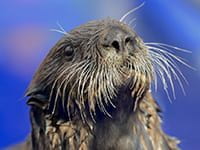
SELKA
Female southern sea otter (Enhydra lutris nereis)
Selka is an adult female southern sea otter born off the coast of California in 2012. After stranding as a pup, she was rescued, rehabilitated, and released into the wild by the Sea Otter Research and Conservation Program at Monterey Bay Aquarium, and she lived as a wild otter for about 2 years. After multiple strandings during this time period, Selka was finally deemed non-releasable by the US Fish and Wildlife Service. She joined our research program in 2014 to participate in sensory studies, and returned to her home at the Monterey Bay Aquarium in August 2016. During her time working with our program, Selka helped us to collect some of the first data linking perceptual capabilities to foraging ecology in sea otters.

NATCHEK
Male ringed seal (Pusa hispida)
Natchek is a male ringed seal who was born in the wild in 1996. After stranding as a pup, Natchek was transferred to SeaWorld San Diego where he lived in the Wild Arctic exhibit as a public display animal. Natchek joined our lab in December 2011 and was a valued research animal and collaborator until he returned to Sea World in December of 2014. Studies of Natchek’s hearing are featured in a 2015 article in the Journal of Experimental Biology. His cooperation in behavioral tests of amphibious hearing changed our understanding of how ringed seals perceive their environment. Natchek, whose name means “ringed seal” in the inupiat language, is one of the most unusual animals we have ever worked with. Known for being stubborn, brave, thoughtful, hard-working, and persistent, Natchek is deeply missed by the entire team.

CHARLIE
Male southern sea otter (Enhydra lutris nereis)
Charlie is an adult male resident southern sea otter of the Aquarium of the Pacific in Long Beach, CA. He joined our program temporarily in 2011 to participate in our ongoing sea otter hearing study. Charlie is one of the most well-tempered and easygoing sea otters that we have had the opportunity to work with. He participated in several hearing projects during his time here, the results of which are described in a 2014 article in the Journal of Comparative Physiology A. His efforts allowed us to gain much-needed insight into the auditory capabilities of sea otters, about which nothing was previously known. Our cooperative work with sea otters has been a special opportunity for the entire team.
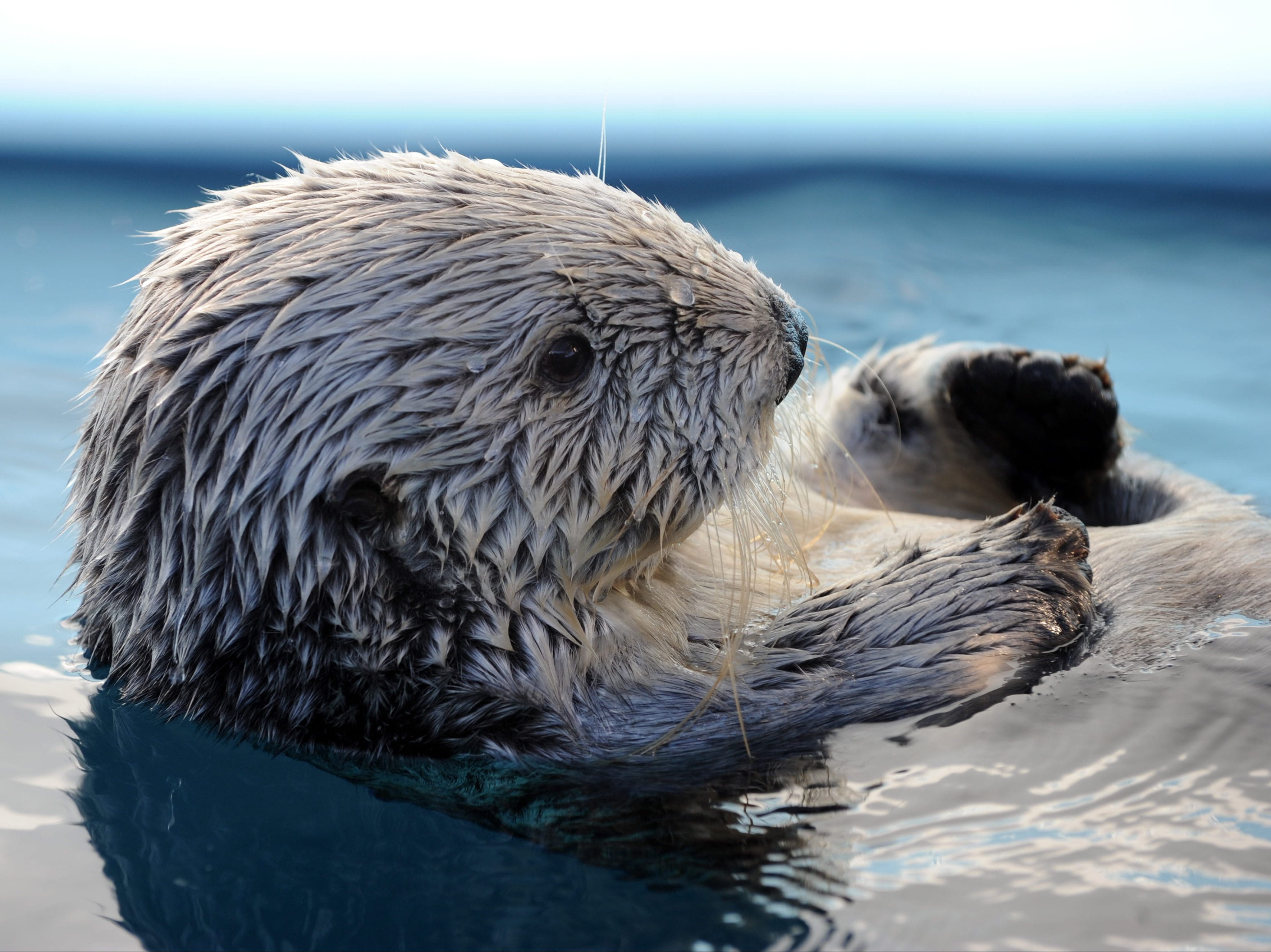
ODIN
Male southern sea otter (Enhydra lutris nereis)
Odin was an adult male southern sea otter who was born in the wild in 2003. He first stranded at approximately three weeks of age, and was subsequently rescued, rehabilitated, and released through the combined efforts of The Marine Mammal Center and the Sea Otter Research and Conservation Program at Monterey Bay Aquarium. After a series of strandings and rehabilitations over the next five years, Odin was officially deemed non-releaseable in August 2008. Odin joined our program at Long Marine Lab in late 2008 to serve as a subject for a study investigating the amphibious hearing capabilities of sea otters. After helping us collect these important hearing data and teaching our team about conducting cooperative behavioral research with otters, Odin unfortunately passed away in June of 2014.

RUFUS
Male southern sea otter (Enhydra lutris nereis)
Rufus was a male southern sea otter who briefly joined our research program in 2008 from Monterey Bay Aquarium’s Sea Otter Research and Conservation Program. Unfortunately, due to his fear of people, Rufus was deemed unsuitable for participation in behavioral research. He was transported back to the Monterey Bay Aquarium when Odin arrived at Long Marine Lab.
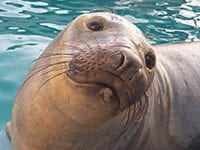
BURNYCE
Female northern elephant seal (Mirounga angustirostris)
Burnyce was born in the wild somewhere near the Channel Islands during the winter of 1993. She beached and was subsequently rehabilitated at Sea World, San Diego, and then transferred to Dr. Schusterman’s care at Long Marine Lab in the spring of 1994. She was just over a year old at the time. Northern elephant seals have rarely been kept successfully in captivity, and Burnyce’s presence in the program presented a special opportunity to learn more about elephant seal behavior, biology, sensory systems, and husbandry in a controlled, captive setting. During her time at Long Marine Lab, Burnyce participated in perceptual tasks involving both audition and vision. For example, her results from a pupillometry study demonstrated that elephant seals can dark adapt remarkably fast – in only about 6 minutes – the time it takes a free-diving elephant seal to reach foraging depths of 600 to 800 m. Burnyce continued to teach us about elephant seal sensory systems, including aerial hearing sensitivity, aerial auditory masking, and directional hearing, until she passed away in 2011.

SADIE
Female northern elephant seal (Mirounga angustirostris)
Sadie was born in the wild during the winter of 1994. She stranded in San Diego and was brought to Sea World, San Diego in April 1994 for rehabilitation. Sadie was placed into Dr. Schusterman’s research program at Long Marine Lab in August 1994, where she was trained to participate in both auditory and visual experiments by the winter of 1995. Sadly, Sadie died of a chronic renal condition in late June of that year.
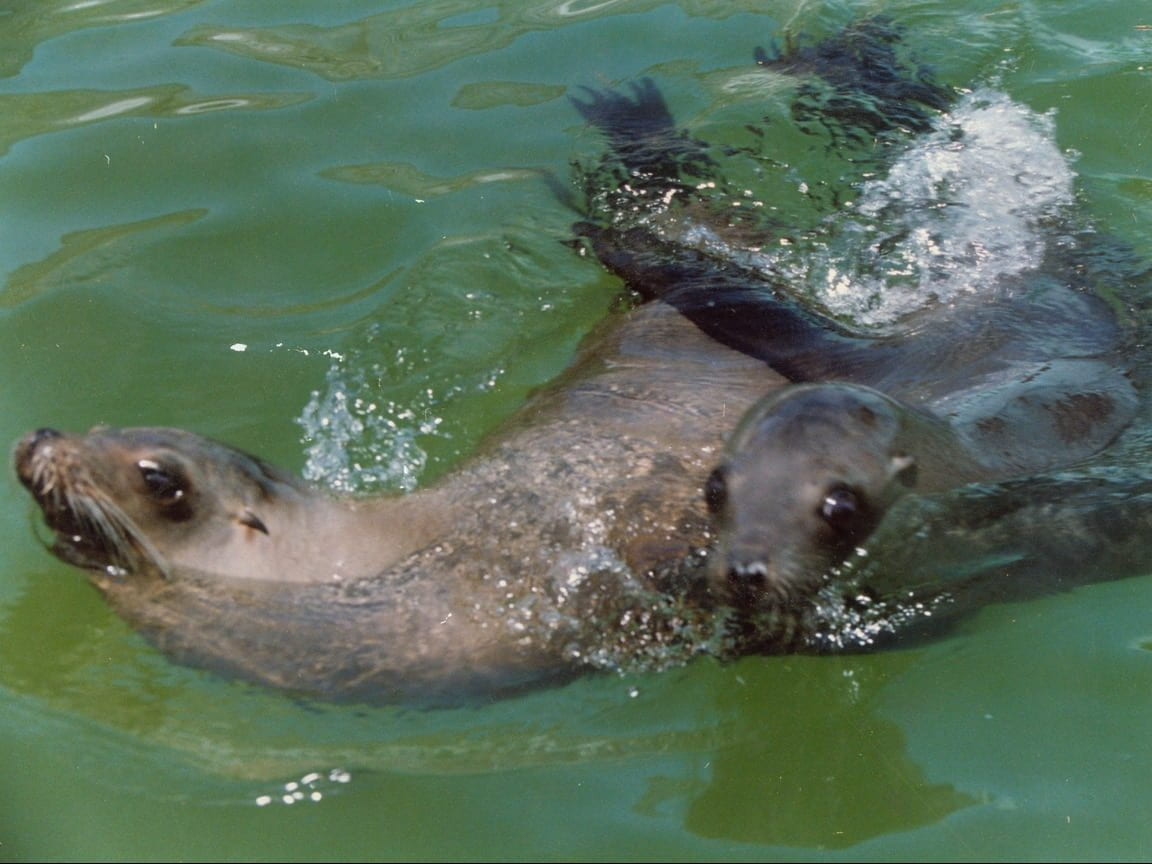
GERTIE
Female California sea lion (Zalophus californianus)
Gertie was born at Marine World in Redwood City, California and is Rio’s half sister (they share the same mother). Gertie lived at Long Marine Lab from 1985 to 1989 and participated in artificial sign language studies throughout that time. Gertie was one of Dr. Schusterman’s animal subjects that demonstrated the ability to understand syntax within a match-to-sample paradigm.
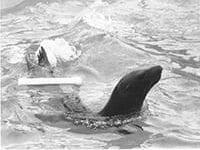
BUCKY
Male California sea lion (Zalophus californianus)
Bucky was born in captivity and lived at Marine World in Redwood City, California. Bucky was one of three sea lions that participated in Dr. Schusterman’s artificial language studies – he worked full-time with the program from 1981 to 1985. Bucky, like Rocky and Gertie, demonstrated the ability to comprehend syntax, particularly with location modifiers.

LORI AND TOBE
Female northern fur seals (Callorhinus ursinus)
Lori and Tobe lived at the Ecological Field Station at California State University, Hayward in the late 1970’s. Both of these fur seals participated in auditory investigations including measurement of absolute hearing sensitivities both in air and under water and measurement of masked hearing thresholds under water. These studies, conducted by Dr. Schusterman and Dr. Patrick Moore, were the first to test the aerial hearing capabilities of pinnipeds in an acoustic chamber. The results demonstrated that fur seals had more sensitive hearing than other pinnipeds tested

SPIKE
Male California sea lion (Zalophus californianus)
Spike lived at the Stanford Research Institute and participated with Dr. Schusterman in a number of studies on visual acuity, sound production, and call directionality in the 1970s. Spike demonstrated that visual acuity in sea lions is compromised by low background light levels, especially in air. These results supported the “stenopaic” hypothesis of amphibious vision in pinnipeds. Spike’s visual acuity curves are still used today to describe how well sea lions see in air and under water.
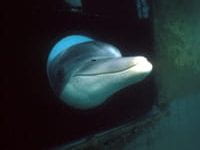
SVEN
Male bottlenose dolphin (Tursiops truncatus)
Sven worked with Dr. Schusterman on a number of echolocation studies in the mid to late 1970s at the Naval Ocean Systems Center in Kailua, Hawaii. These included investigations of target discrimination, stimulus control over echolocation pulses, and how attention and response bias during discrimination tasks may affect experimental outcome.

JO
Female bottlenose dolphin (Tursiops truncatus)
Dr. Schusterman worked with Jo at the Naval Ocean Systems Center in Kailua, Hawaii. Jo was trained to participate in a number of experimental procedures, including a passive sound detection task in which the payoff matrix was manipulated. Dr. Schusterman compared her results with those of one sea lion subject to show that varying the payoff matrix can be an effective way to address the response biases developed by marine mammals during psychophysical testing.

EKAHI
Male bottlenose dolphin (Tursiops truncatus)
Ekahi lived at the Naval Ocean Systems Center in Hawaii in the mid to late 1970s while Dr. Schusterman was a visiting researcher there. The two cooperated in a number of echolocation studies. The results of this work were used to describe behavioral techniques for researchers of marine mammal psychophysics, including how to train stimulus control over echolocation pulses in dolphins.

SAM (a.k.a "old wart lip)
Male California sea lion (Zalophus californianus)
Sam was born in the wild and lived in captivity from the age of two, first at the Stanford Research Institute and then at California State University, Hayward. Throughout the 1970’s, Sam was involved in a number of studies including those investigating sea lion sound production, auditory sensitivity, frequency discrimination, sound intensity discrimination, visual acuity and shape discrimination, mirror studies, and the effects of signal probability and variation in reinforcement schedules on responding in psychophysical tasks. Through his participation in Dr. Schusterman’s research program, Sam contributed greatly to our knowledge of sea lion perceptual and cognitive capabilities.
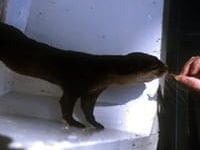
TOM AND JERRY
Male Asian clawless otters (Amblonyx cineria cineria)
Tom and Jerry both lived first at the Stanford Research Institute and then at California State University, Hayward. They participated in studies conducted by Dr. Schusterman from 1970-1975 on underwater and aerial visual acuity. Their results on these tasks were compared to those of sea lions tested in similar procedures in order to determine how an “otter eye” operated relative to a “pinniped eye.” Results from these studies demonstrated that aerial and underwater visual acuity were similar in this otter species, but inferior to that of sea lions in both media.

GOLDIE
Male harbor seal (Phoca vitulina)
Goldie lived at the Stanford Research Institute until 1971, when Ron moved his lab to the Ecological Field Station at California State University, Hayward. Goldie participated in shape and size discrimination tasks as well as in visual acuity studies. Goldie’s visual abilities were compared with those of the many sea lion subjects that Dr. Schusterman had already tested. Goldie’s visual acuity was not quite as good as that of the sea lion subjects, but was superior to that of the Asian “clawless” otters, Tom and Jerry.

RUNNER
Male Steller sea lion (Eumetopias jubatus)
Runner worked with Dr. Schusterman on a number of studies on visual acuity, size discrimination, and underwater sound production in pinnipeds during his stay at the Stanford Research Institute in the late 1960s. His visual acuity was superior to a harbor seal’s (Goldie’s) and comparable to the several California sea lions that were also tested at the time.
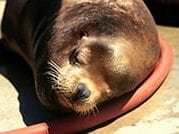
MARTY, GROWLER, PEABODY, NEKKY, AND SPIKE
Male California sea lions (Zalophus californianus)
This group of male sea lions lived at the Stanford Research Institute during the mid to late 1960’s. Dr. Schusterman observed these individuals during a number of investigations of pinniped behavior, including those relating to sea lion sound production and directionality of barks, development of a seasonal fatted male phenomenon, and male social dominance.

BIBI
Female California sea lion (Zalophus californianus)
Bibi was born in the wild, but lived at the Stanford Research Institute since she was a yearling in 1964. Dr. Schusterman’s collaboration with Bibi was a very productive one; the two completed many investigations of sound production, size and shape discrimination of underwater objects, reversal learning, echolocation ability, and visual acuity. Bibi’s performance in object discrimination experiments demonstrated for the first time that sea lions, unlike dolphins, do not possess sophisticated biosonar capabilities.

ROCKY
Female California sea lion (Zalophus californianus)